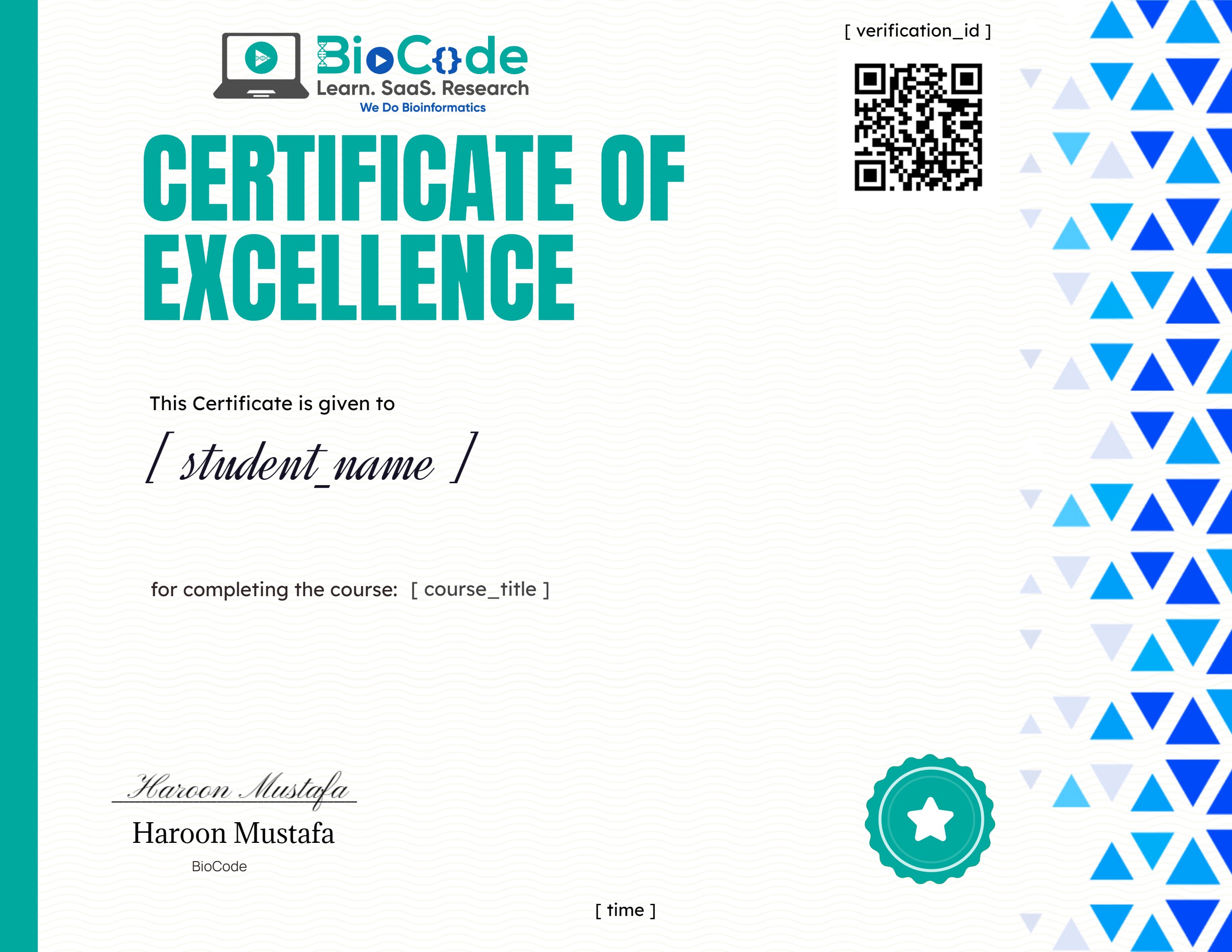Beginners R For Bioinformatics
About Course
The major part of bioinformatics is connecting together different processing steps into a single pipeline, and then applying that pipeline to many other files repeatedly, which often involves massive and tedious data processing. R is one of the most widely-utilized and powerful programming languages in bioinformatics. R stands out in the areas of research where a variety of statistical tools are required, e.g. RNA-Seq, microarray analysis, statistical testing, biological data visualization, population genomics and in the production of publication-quality graphs and figures.
BioCode is offering a Beginners R for Bioinformatics course in which you’ll learn various concepts related to writing customized scripts in R language, you’ll learn about various built-in functions and packages provided by R. You will be able to write built-in functions in R, work with loops and know how to control the flow of your program and script. R language is considered as the most suitable prohgramming language for biological data analysis, statistics, and graph plotting.
If you’re a beginner in bioinformatics, an experimental biologist, a bioinformatics researcher, or someone with no knowledge of scripting or bioinformatics, our course will help you greatly. Everything will be taught in this course from basics of scripting in R language to advanced level. This course will also provide you with a great foundation and understanding of biological scripting in R.
This course will include the following sections:
Section 1: Introduction to the R Language
Description: This section will focus on making sure that the students gain an understanding about R language and how it is installed.
Learning Outcomes: Upon completion of this section, students will be able to:
- Discuss R Language.
- Install R Language.
- Describe the R Studio Interface.
- Explain the Concept of Comments.
Section 2: Variable and Function in R Language
Description: This section will focus on making sure that the students learn about the various variables and functions provided by the R language and their use.
Learning Outcomes: Upon completion of this section, students will be able to:
- Explain Samples and Replacement.
- Declare Variables and Objects.
- Use Built-in Functions and ARGS.
- Write their Own Functions and Arguments.
- Create Customized Scripts.
Section 3: Vectors and Data Types in R Language
Description: This section will focus on making sure that the students learn about the vectors and data types that are used in R language.
Learning Outcomes: Upon completion of this section, students will be able to:
- Explain Attributes and Names.
- Explain Characters, Integers, Doubles, Logicals, and Factors in R.
- Explain Atomic Vectors in R.
- Discuss Dim and Dimensions in R.
- Describe Coercion.
- Describe Matrix and Matrices.
- Explain Arrays and Lists.
- Describe Class in R.
Section 4: Packages in R Language
Description: This section will focus on making sure that the students learn about the packages that are needed to install in R language.
Learning Outcomes: Upon completion of this section, students will be able to:
- Discuss Packages in R.
- Install Bioinformatics Packages in R.
Section 5: Biological Data Analysis in R
Description: This section will focus on making sure that the students learn how is biological data analysis performed in R language.
Learning Outcomes: Upon completion of this section, students will be able to:
- Describe Zero Notation for Subsetting Biological Datasets.
- Load Biological Data.
- Save Biological Data.
- Perform R Notation and Select Values from Biological Datasets.
- Explain Data Frames.
- Discuss Positive Integers for Subsetting Biological Datasets.
- Discuss Negative Integers for Subsetting Biological Datasets.
- Explain Dollar Signs for Subsetting Biological Datasets.
- Explain Blank Spaces for Subsetting Biological Datasets.
- Modify Values in Existing Datasets.
- Explain NA (Not Available) Values in Biological Datasets.
- Figure out NA Values in Biological Datasets.
- Perform Logical Subsetting in Biological Datasets.
Section 6: Control Flow
Description: This section will focus on making sure that the students learn how the flow of the program is controlled while scripting.
Learning Outcomes: Upon completion of this section, students will be able to:
- Use If Else Statement in Code.
- Use For Loops and Perform Biological Data Binding.
- Use While Loops and Read Multiple Biological Datasets.

Course Content
Introduction
-
Introduction to R in Bioinformatics & R Installation
09:48 -
The R Studio Interface Explanation
06:23 -
Comments
04:17
Variables & Functions
Vectors & Data Types
Packages
Biological Data Analysis
Control Flow
Evaluation
Earn a certificate
Add this certificate to your resume to demonstrate your skills & increase your chances of getting noticed.

Student Ratings & Reviews


